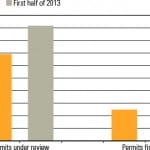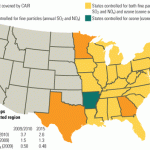A three-judge panel of the U.S. Court of Appeals for the D.C. Circuit on June 26 unanimously rejected all pending legal challenges against the U.S. Environmental Protection Agency’s (EPA’s) interpretation of the Clean Air Act (CAA) that allows the agency to regulate greenhouse gases (GHGs). What is the EPA’s future strategy in its war on coal?
The court’s ruling went against 90-some legal challenges, consolidated into four separate lawsuits, claiming the EPA erred in the science used to develop the Endangerment Finding and in its interpretation of the CAA. The court found that the EPA was “neither arbitrary nor capricious” in preparing the Endangerment Finding and that the agency was “unambiguously correct” in its interpretation of the CAA giving it the power to regulate GHGs. In boxing, this is called a technical knock-out.
Comments on the final Carbon Pollution Standard (CPS) were due June 25. This rule sets a GHG new source performance standard (NSPS) at 1,000 lb/MWh CO2e, roughly equal to emissions from a gas-fired combined cycle plant. An average coal plant in the U.S. emits roughly 1,800 lb/MWh. Sequestering the excess CO2 emissions is also an option under the CPS, although not practical, because the technology is still unproven at the scale required. The CPS is a de facto ban on the construction of new coal plants. Another barrier to new coal plants: CAA Prevention of Significant Deterioration and Title V permit regulations for GHGs became effective in January 2011 for facilities that emit 100,000 tons per year or more of CO2e or facilities that increase their CO2e emissions by 75,000 tons per year.
Tactical Advantage
The CPS specifically exempts modified coal-fired plants from meeting the new CO2e performance standard, even though Section 111 of the CAA requires modified sources to be regulated as “new sources.” Section 111(a) defines a “new source” as “any stationary source, the construction, or modification of the plant” that is regulated. A modification is defined as any physical change in the plant that increases emissions, which now includes GHGs. Expect existing coal-fired plants to be brought under the CPS post-election, despite recent EPA protestations to the contrary.
An image of the trap being set for the power industry is now coming into view. Plant owners must pay close attention to the impact that physical environmental upgrades have on increasing CO2e emissions. Adding a new air quality control system (AQCS) to a plant, such as a selective catalytic reduction or flue gas desulfurization system, will reduce overall plant power production (the draft GHG rules use overall plant-level emissions), mostly due to the increased auxiliary power required to operate the AQCS equipment. Reduced plant efficiency increases the CO2e produced per MWh. Meeting the Cross-State Air Pollution Rule (CSAPR), Utility MACT, and the rest of the pending rules being spawned by the EPA will only further reduce plant operating efficiency, producing still more CO2e emissions per MWh.
Master Plan at Work
I believe that the EPA expects, once the massive AQCS upgrades required by CSAPR and Utility MACT are complete, that many plants will produce sufficient “modified emissions” to become “new emission” plants, requiring compliance with the CPS, as newly interpreted. Compliance with a new coal combustion residuals rule, Clean Water Act Section 316(b) updates, and delayed ozone rules that are expected to be released after the election will also increase CO2 emissions. The similarities with the judicial history of the New Source Review (NSR) program, which surely inspired this tactic, are uncanny.
Ironically, the designation of “new emission” plants can only occur after owners’ investment of billions of dollars for new AQCS equipment to remove criteria pollutants required by the CSAPR, Utility MACT Rule, and the like.
Recall that plant owners have been self-reporting data on plant modifications since the 1970s by virtue of the NSR, CO2 emissions since Jan. 1, 1995, and further CO2 records since October 2009. With this information, the EPA could easily separate out the “new emissions” soon after new AQCS and other compliance equipment enters service and quickly identify self-reporting CPS offenders.
The EPA could then force immediate coal plant retirements when the full weight of the Department of Justice is applied to a CPS infraction. Much like NSR infractions, I would expect these infractions to be “negotiated” plant closures in order to achieve much short-term gain for little long-term legal pain. There is ample legal precedent from other industries that establishes a “modified emission” as a “new emission,” after plant upgrades have been completed. In those cases, the EPA has enforced the NSPS rather than granting waivers.
Coordinated Attack Imminent
The EPA, by staunchly defending a three-year compliance schedule for the CSAPR and Utility MACT, is expecting that most AQCS construction will be completed during the next presidential term, providing just enough time to hit existing plants with a CPS citation for their “new emissions.” Those citations, much like the NSR citations, will then be in the Justice Department, outside the reach of a new president. President Obama’s 2008 prediction of bankrupting utilities that rely on coal-fired generation could then become reality during a second term and beyond.
This war on coal strategy assumes three independent events will occur: pending court challenges to the EPA rules will eventually be dismissed, the passive response by Congress to the EPA’s actions continues, and President Obama is reelected. The courts will determine the first; you will decide the others in about three months.
— Dr. Robert Peltier, PE is POWER’s editor-in-chief.










